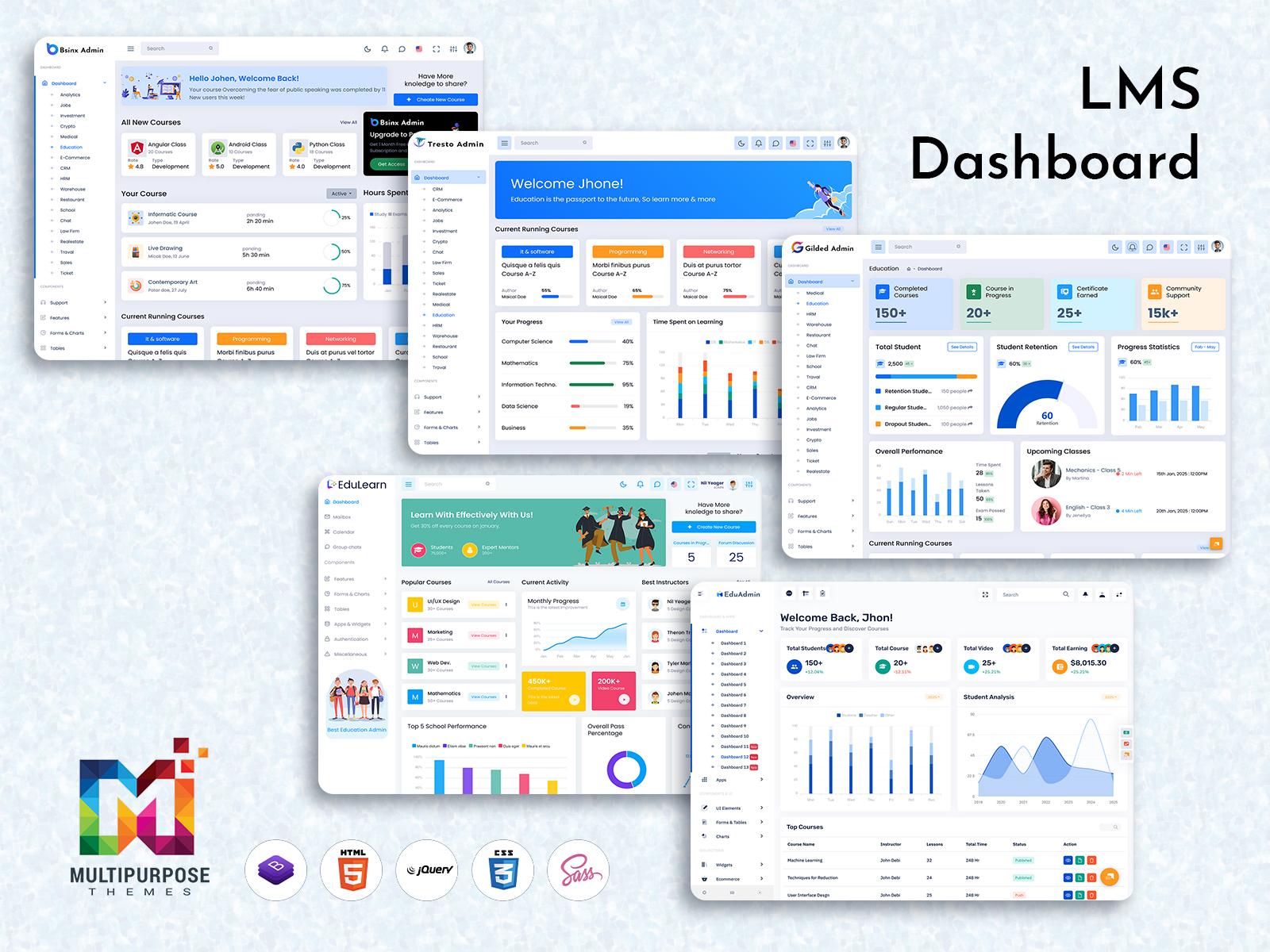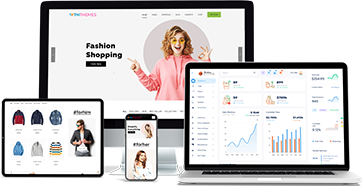In the fast-evolving world of education, managing academic operations effectively is no longer a luxury—it’s…

Learning Management System Dashboard: Your Central Hub
Reading Time: 5 minutes
In today’s digital world, online learning has become a crucial part of education. Whether you’re an individual learning a new skill, a teacher managing multiple students, or a business providing employee training, staying organized is key. That’s where a Learning Management System Dashboard comes in. It’s a user-friendly interface that brings everything together, making it easier to track progress, manage courses, and stay on top of tasks. But what exactly is an LMS Dashboard, and how can you use it effectively? Let’s dive in!
BUY NOW Check all DEMOs
The Power of LMS Dashboard Templates
When it comes to implementing an LMS Dashboard, the right LMS Dashboard Template can make a huge difference. The Edulearn LMS Admin Template is an excellent choice for those looking to build or upgrade their Education Dashboard. With over 50+ frontend HTML pages and RTL support, this Learning Template provides all the features necessary to create a highly functional and visually appealing e-learning platform.
The Edulearn LMS Dashboard Template is built on the Bootstrap 5 Admin Template, which ensures that your dashboard is responsive, mobile-friendly, and adaptable to different screen sizes. It also includes powerful tools for managing users, courses, assignments, and reports, making it an all-in-one solution for your e-learning needs.
Understanding the Core Functions of an LMS Dashboard
At its core, the LMS Dashboard is the central hub of any Learning Management System. It acts as the go-to place for everything you need to know about your courses, progress, and deadlines. With all the important information in one spot, you can save time and energy, focusing more on your learning or teaching rather than searching for the right content.
Centralized Information Access
Imagine having everything you need for learning in one place. That’s what the Learning Management System Dashboard provides! Whether it’s your course materials, updates, assignments, or resources, the dashboard brings everything together in a simple, easy-to-navigate layout. You won’t have to jump from page to page to find the information you need, which makes your online learning experience more efficient.
Navigation and Orientation
The Learning Dashboard acts as your guide throughout the LMS. With clearly organized menus and a well-designed interface, it makes navigating the system a breeze. Want to check your assignments or find a specific module? The dashboard makes it simple to locate what you’re looking for, allowing you to spend less time searching and more time learning.
Progress Tracking and Monitoring
One of the key features of any LMS Dashboard is progress tracking. Visual indicators like charts and graphs allow you to monitor your learning journey. You can easily see which courses you’ve completed, your current grades, and upcoming deadlines. This helps you stay motivated and on track. Admins also benefit from this feature as they can monitor the progress of all learners, identifying areas that might need further attention.
Key Components of an Effective LMS Dashboard
An effective LMS Dashboard includes several key components that enhance the learning experience. These elements work together to ensure smooth navigation, progress tracking, and communication. Let’s take a closer look at what makes an LMS dashboard truly effective.
Course Overview and Enrollment Status
The dashboard shows all the courses you’re enrolled in, with essential information like course start dates, deadlines, and completion rates. This helps you stay organized, ensuring you never miss important dates. You can see which courses are due, which ones are coming up, and what you’ve already completed, keeping you on track with your learning goals.
Announcements and Notifications
The Learning Dashboard ensures you stay up-to-date with any important announcements from instructors, administrators, or the LMS platform itself. It alerts you to new content, schedule changes, reminders, and other updates. This ensures you’re always informed, helping you stay on top of your learning or teaching responsibilities.
Performance Analytics and Reporting
A well-designed LMS Dashboard doesn’t just show you your progress, it also provides data that can help you improve. Learners can see detailed reports on their performance, assignments, and overall progress. Meanwhile, administrators have access to detailed reports on course completion, student engagement, and much more. These analytics allow both learners and admins to track progress and identify areas for improvement.
Benefits of a Well-Designed LMS Dashboard
A Learning Management System Dashboard provides numerous benefits to both learners and administrators. It not only simplifies the learning experience but also streamlines administrative tasks.
Enhanced User Experience
One of the biggest advantages of a well-designed LMS Dashboard Template is the improved user experience. An intuitive, easy-to-use dashboard helps learners stay engaged and motivated. With simple navigation, learners can quickly find what they need and focus on their coursework instead of struggling with complex interfaces. The easier it is to use, the more likely students will stay engaged with their learning.
Improved Learning Outcomes
With everything you need at your fingertips, it becomes easier to achieve better learning outcomes. An LMS Dashboard that clearly displays progress, deadlines, and performance makes it easier to stay on top of your work. You’ll know exactly where you stand, what needs to be done, and how much progress you’ve made. This clarity can lead to better performance and deeper learning.
Streamlined Administration and Reporting
For administrators, a Learning Management System Dashboard is invaluable. It centralizes all relevant data in one place, making reporting and progress tracking simpler. Admins can easily monitor course completion, learner engagement, and performance, enabling them to make data-driven decisions. This streamlined approach improves the overall effectiveness of the LMS.
Optimizing Your LMS Dashboard for Maximum Impact
To get the most out of your LMS Dashboard, it’s important to customize it to your needs. A few tweaks can make a huge difference in terms of efficiency and ease of use.
Customization and Personalization Options
The best part about a modern LMS Dashboard is its customization options. You can personalize the layout, adjust colors, and choose which widgets to display. By tailoring the dashboard to fit your needs, you can improve your overall learning experience. Whether you’re a student who wants quick access to assignments or an admin who needs detailed analytics, customization allows you to make the dashboard work for you.
Prioritizing Key Information and Metrics
The LMS Dashboard often displays a lot of information. To make sure you focus on what matters most, it’s important to prioritize key data points. For example, if you’re a learner, you might want to have your current courses and deadlines displayed prominently. If you’re an administrator, focusing on reports and engagement metrics can help streamline decision-making.
Ensuring Mobile Responsiveness
Since learners and instructors may access the LMS Dashboard from various devices, ensuring the dashboard is mobile-friendly is essential. A Bootstrap Admin HTML template that is responsive ensures that the dashboard looks great and functions well on all devices—whether you’re using a phone, tablet, or computer. This makes it easy to stay connected and manage your learning on the go.
Real-World Examples of Effective LMS Dashboards
Different organizations use LMS Dashboards to enhance the learning experience. These real-world examples highlight best practices that make learning more organized and efficient.
Corporate Training Example
Many companies use Learning Management System Dashboards for employee training. These dashboards track employee progress in mandatory training courses, compliance, and professional development. By having all this information in one place, managers can easily monitor employee progress, ensuring that everyone stays up-to-date with necessary training.
Academic Institution Example
Schools and universities use LMS Dashboards to manage student learning. Students can access their courses, view grades, submit assignments, and communicate with instructors. The dashboard serves as a central hub for all academic activities, making the learning process more organized and accessible for students and faculty alike.
Conclusion
The Learning Management System Dashboard is a crucial tool for both learners and administrators. It simplifies access to resources, helps with tracking progress, and enhances the overall learning experience. With the right dashboard, learning becomes more organized, motivating, and efficient. Whether you are a student, instructor, or admin, optimizing your LMS Dashboard can significantly improve your online learning or teaching experience.
If you’re looking to create your own LMS Dashboard, you can explore LMS Dashboard Templates like Edulearn Admin Template, which offers clean designs, responsive features, and easy customization. Whether you’re building an Elearning Dashboard, managing an online classroom, or offering corporate training, having the right Bootstrap 5 Admin Template can make all the difference. Embrace the power of the Learning Management System Dashboard and unlock a world of learning opportunities!
Buy Now and Get Started Today!
Click below to purchase and start unlocking the full potential of your business!
 skip to Main Content
skip to Main Content




This Post Has 0 Comments